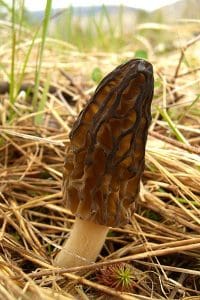Black Morel / Spring / Edible
Indulge in the exquisite flavors of the Black Morel (Morchella elata) as we embark on a culinary adventure celebrating this prized mushroom.
Join us in savoring the unique delights offered by nature’s culinary masterpiece. With its distinctive conical cap and characteristic honeycomb-like texture, the Black Morel stands as a true delicacy.
Learn to identify its captivating features, discover its preferred habitats, and delve into the culinary wonders it bestows. From its earthy, nutty flavor to its tender and meaty texture, this mushroom has the power to elevate your culinary creations to extraordinary heights.
Whether you are an experienced forager or a passionate home cook, let the Black Morel inspire your culinary artistry and tantalize your taste buds with its marvelous flavors. Embrace the abundance of nature’s bounty as we celebrate the enchanting delights that lie within the Black Morel. Get ready to embark on a flavor-filled journey as we explore the captivating culinary possibilities offered by this remarkable mushroom.
Scientific Name
Morchella elata
Family
Morchellaceae
Habitat
Europe, including Britain, temperate regions of Asia, North Africa, North America. They grow in varied habitat – Fields, hedgerows, open woodland, clearings and waste ground and burnt ground. They often turn up in fresh wood chippings put down as mulch in gardens, but seldom come back once the chippings have weathered in and the mycelium runs out of steam.
Description
Morchella elata is a type of fungus, descended from Cup fungi or Ascomycetes. Although the fruit bodies have a stem they lack the gills or pores of other mushrooms, instead releasing spores from a surfaces of fused irregular cups.
Identifying Features of the Black Morel
Cap
Each mushroom begins as a small greyish sponge with lighter ridges, then expands into a vaguely cone shaped deep brown cap raised on a large white stem. The mature cap varies in colour from to grey to dark brown, often with a burnt appearance, and is made up of large pits and ridges joined together in an irregular, blobby honeycomb structure. The caps measure 2–7 centimetres (1–3 inches) broad by 2–10 cm (1–4 in) tall, and when cut open are hollow, with one large space extending right through the cap and stem. The pits irregularly shaped with rounded edges

Stem
The hollow stem is creamy white to yellow in colour, typically 2–9 cm (1–3 1⁄2 in) long by 2–5 cm (1–2 in) thick.
Spore
White to Cream
Uses of the Black Morel
Food
Morels are a much sought after delicacy, popular in cuisine across the world. They can be fried, baked, combined with other mushrooms in sauces, pies, stews… They can also be dried to preserve them, which also concentrates the flavour
Medicine
Morchella species are used in traditional Chinese and Himalayan medicine to treat intestinal problems and shortness of breath . Studies have noted some anti-inflammatory, anti-tumour and immune regulation effects
Known hazards
Morels are poisonous when raw, containing the irritant hydrazine. This is broken down by heat, so they should be cooked for at least 10 minutes before eating. Or to be completely safe, the mushrooms should be parboiled and the water thrown away before cooking as yoy would any other mushroom.
Harvesting
Appears March to June
Potential lookalikes
The Stinkhorn Phallus impudicus has a pale stem and grey-brown cap, but isn’t pitted in the same way and absolutely stinks of rotten meat. You certainly wouldn’t be likely to want to eat it! You’re much more likely to confuse the Black morel with other edible morchella species such as the Yellow or True morel, morchella esculenta, which is has a lighter yellowy brown and more rounded cap. Beware of the False Morel Verpa bohemica, which has deep wrinkles on the cap but not the characteristic deep cups of the true morel, and the Thimble Morel, Verpa conica, which has a much smaller cap in relation to its stem, and the cap is smoother, hanging free and unattached to the stem at the bottom. Both of these Verpa species can make you unwell.





